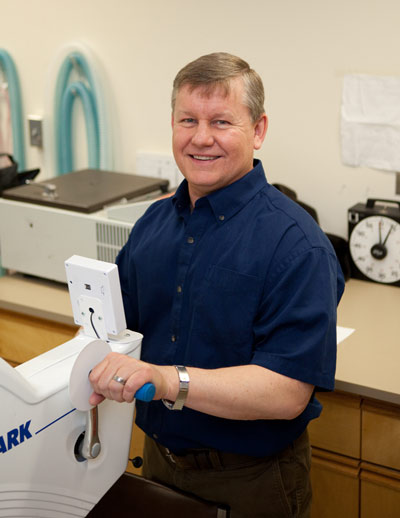
Veteran educator, exercise physiology professor Gordon Bell is the faculty's newest Rutherford Award winner
When veteran teacher Gordon Bell goes into his exercise physiology class, students can depend on three things without fail - a well-prepared lesson, energetically delivered in language they can understand, and one that tries to engage them from start to finish. The key, he says, lies in meticulous preparation.
These are the well-ingrained lessons Bell attributes to being formally trained as a teacher, having completed an education degree and taught in the secondary school system before advancing to a second degree in kinesiology and going onto graduate studies - and an academic career at the University of Alberta.
Bell adds that his own teaching style was influenced by several great teachers he experienced at school and university, and his current colleagues.
"I draw heavily on my formal teacher training: I try to prepare myself and the material as well as possible. I think it's important that there's a definite plan and you convey that to the students and they know what they're going to be learning. I think students really respond to that."
To Bell, these are, quite simply, the nuts of bolts of good teaching practice, that make for a good learning experience for students.
Teaching in larger classes with plenty of technological distractions - phones, laptops and ready access to the internet - can be challenging. But that's where using what Bell calls "the whole tool box of teaching management skills " in addition to using the best teaching technique to fit the subject or concept. It also means fostering a spirit of mutual respect in an environment that's "motivating and non-threatening."
"I try to convey to the students that they are in class for a reason and so am I," says Bell. "That means if I say, 'you don't need your phone to learn in this class,' it's shut off so students can stay focused. It means if you're using your computer in class, you're not logged into the internet and distracted."
"Using techniques, such as walking around the classroom - making sure your presence is felt and that students are engaged in the process, can be effective. It also means taking time to pose or entertain questions and to try to provide the best answer for the student in class and if you're unable to, to get back to them." Students appreciate that and it helps the instructor continually learn as well.
Bell works hard to ensure that students understand the relevance of what they're learning in real-life contexts so they know how to apply them. In his fitness assessment classes, he uses examples from his work in the Sport and Health Assessment Centre, where the Oilers frequently come for their fitness testing. "When I mention the work we do with the Edmonton Oilers or some other elite athlete everyone pricks up their ears. I try to give examples that are real in their lives to help them to make a connection with what it means and how the theory is applied."
Being available to students is a hallmark of Bell's style. "No student should ever say, 'I have no idea what went on in class today.' As a student, if you go into the class and are prepared, you shouldn't be wondering what happened in class, but sometimes students say this about some of their classes. It's not uncommon to hear that. That's simply poor communication - no teacher should allow that to happen."
The classroom should be an engaged space where true learning takes place - not just note-taking and memorization later, says Bell. "I believe you should be able to learn something in the classroom that doesn't require you to memorize it later. Some level of understanding should be achieved before you head out of the door. That comes back to being prepared and using the best information and method to teach the concept."
Asked what he loves about teaching, Bell says, "I do have a personal desire to help people to learn. I get fulfillment out of teaching someone something and then getting feedback about how they used it.
"Sometimes I'll get an email from a graduate who tells me that they're using some concepts they learned in class and applying it in their own work. One student wrote to say, 'these things that we learned in your class, I've created information summaries on those topics and given them to the athlete group I'm working with and they're right out of your notes and things we discussed in class ' And even some parents of those kids came up and said 'that was great information.' So when I see that something we did in class get carried over and used by a student in the community that makes all the difference."